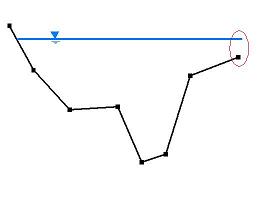HY8:Irregular Channel Error: Difference between revisions
No edit summary |
No edit summary |
||
| Line 14: | Line 14: | ||
{{ | {{HY8Main}} | ||
}} | |||
Revision as of 16:15, 1 July 2011
When the capacity of an irregular channel is not sufficient to convey the range of discharges, version 6.1 of HY-8 “spilled” excess water into an infinitely wide floodplain (see drawing below). The rating curve shows a constant tailwater elevation, cross-section velocity and computed shear stress for all discharges exceeding the channel capacity.
In HY-8, the “spill” concept is not used. If the irregular cross section cannot convey the range of discharges entered by the user, the following error message is displayed: “Irregular tailwater channel is not big enough to convey flow.”
The user has two options to correct this error. The first option is to enter additional data points for the purpose of extending the cross section horizontally and vertically based on field surveys or best judgment. This option could be used to simulate the “spill” concept of HY-8 by simulating a very wide floodplain with extended channel points. A second option is to create vertical walls to trap the flow so the depth of flow increases. Previous versions of HY-8 simply "spilled" excess flow onto an infinitely wide floodplain (Figure 3), resulting in a constant rating curve above the lowest cross section endpoint.
